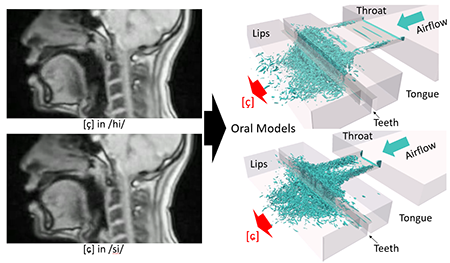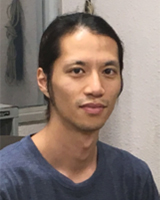
ここからコンテンツです。

How Japanese speakers confuse the pronunciations of /hi/ and /si/
Real-time MRI and supercomputer simulations reveal the production mechanisms of these sounds in a Japanese dialectTsukasa Yoshinaga
According to a linguistic survey report, people often confuse the pronunciation of /hi/ ([çi] in the IPA phonetic alphabet) with that of /si/ ([ɕi]) in the dialect of Tokyo and the Tohoku region of Japan. A team of researchers at Toyohashi University of Technology and the National Institute for Japanese Language and Linguistics (NINJAL) found that the confusion is resulted from the articulation of the tongue varying in the transverse direction while the tongue tip is positioned at the same place of articulation.
In the Japanese language, the consonant /s/ followed by vowel /i/ is pronounced [ɕi], distinct from /s/ followed by other vowels [sa], [sɯ], [se], and [so], because of the palatalized tongue articulation. Similarly, /h/ followed by /i/ is pronounced [çi], distinct from /h/ followed by the other vowels [ha], [ɸɯ], [he], and [ho]. In both cases, the articulation is palatalized and often confused. For example, the initial syllables of Japanese words /higasi/ “east” and /hige/ “mustache” are often pronounced /sigasi/ and /sige/, respectively, in Tokyo and a wide area of the Tohoku region of Japan. In addition, the initial syllable of /sichigatsu/ “July” is variably pronounced as /hichigatsu/ throughout Japan. This phenomenon has already been known by researchers in linguistics. However, it was still unclear how the acoustic contrast between the two sounds /hi/ and /si/ was reflected from their articulation.

In this study, the research team observed the tongue movement during the articulation of a Japanese sentence “korega hisi gata” (“This is a rhomboid shape.”) by 10 Japanese subjects using real-time MRI, and found that 3 subjects pronounced /hi/ and /si/ with almost identical places of articulation, while the acoustic contrast between /hi/ and /si/ was audible.
To examine how the acoustic contrast was formed with an apparently identical place of articulation, the research team conducted numerical flow simulations on oral models using a supercomputer. The results demonstrated that the acoustic contrast between /hi/ and /si/ can be produced by the difference in tongue shape in the transverse direction without changing the place of articulation.
In the classification of the International Phonetic Alphabet (IPA), the place of articulation is mainly defined by the position of the narrowing of the oral passage in the anterior-posterior direction. However, the current findings show the possibility of changing the sounds of /hi/ and /si/ with different tongue shapes in the transverse direction, suggesting the necessity of including a new parameter for the IPA.
"The pronunciations of /hi/ and /si/ are often used in Japanese and articulated unintentionally in a daily conversation,” says the lead author Tsukasa Yoshinaga, assistant professor at Toyohashi University of Technology. “However, to simulate the production of these sounds in our mouths, we need to precisely calculate the generation of many small vortices in turbulent airflow and the sound propagation from these vortices. To simulate them, approximately 80 million computational grid points were set, and the formulas were solved on the grids using a supercomputer. We were excited when we found small vortices causing the acoustic contrast between /hi/ and /si/ in the simulation results."
For future research, the research team believes that understanding the cause of the acoustic contrast between /hi/ and /si/ will provide useful information for obtaining fluency in Japanese articulation. In addition, this knowledge can be useful for the rehabilitation of articulation disorders with speech therapists. Currently, coauthor Kikuo Maekawa, professor at NINJAL, is developing a database of articulatory movies of real-time MRI. Additional analysis for the other syllables will provide us useful information for speech therapists as well as learners of Japanese as a second language.
This work was supported by MEXT as "Program for Promoting Research on the Supercomputer Fugaku" (hp200123, hp200134), JSPS KAKENHI (Grant numbers: JP17H02339, JP19H03976, JP19K21641, JP20H01265, and JP20K14648), and the research budget of the Center for Corpus Development, National Institute for Japanese Language and Linguistics.
Reference
Tsukasa Yoshinaga, Kikuo Maekawa, and Akiyoshi Iida. Aeroacoustic differences between the Japanese fricatives [ɕ] and [Ç]. The Journal of the Acoustical Society of America 149, 2426 (2021)
https://asa.scitation.org/doi/10.1121/10.0003936
「ヒ」と「シ」の発音を混同するメカニズムを
リアルタイムMRIとスーパーコンピュータにより解明
吉永 司
豊橋技術科学大学の吉永司助教、飯田明由教授と国立国語研究所の前川喜久雄教授からなる研究チームは、関東や東北地方の方言などで観察される「ヒ」と「シ」が混同して発音される現象に関して、リアルタイムMRIとスーパーコンピュータを用いた解析により、舌の位置は変えずに舌の左右方向の形状を変化させて発音していることが原因であることを明らかにしました。
日本語の発音では、サ行の「シ」音声記号[ɕi]の子音は、「サ」[sa]や「ス」[sɯ]の子音と異なっています。「サ」の子音は舌の先端を歯茎に近づけて発音するのに対し、「シ」の子音は舌の位置を歯茎の辺りから少し後方にずらすことで、「サ」や「ス」と区別しています。一方、ハ行の発音の中で「ヒ」[çi]の子音は、「ハ」[ha]や「へ」[he]の子音に比べて舌の位置が歯茎に近い前寄りになっています。そのため、「シ」と「ヒ」の舌の位置は似ており、東京や東北の広い地域において、「東」を「ヒガシ」ではなく「シガシ」と発音したり、「髭」を「ヒゲ」ではなく「シゲ」と発音することが知られています。また、「7月」を「シチガツ」ではなく「ヒチガツ」と発音する人は日本中で見られます。この2つの発音が混同してしまう問題は広く知られており、その原因は発音時の舌の位置が似ているためと言われていましたが、具体的にどのように音を区別して発音しているのかは明らかではありませんでした。
そこで研究チームは、発音時の舌が動く様子を観察できるリアルタイムMRIにより、東京方言話者の被験者10名が「これがヒシがた」と発音する際の「ヒ」と「シ」の舌の位置を観察しました。その結果3人の被験者において、「ヒ」と「シ」を発音する際の舌の前後の位置はほとんど同じであることを発見しました。この時、被験者らの舌の位置は同じであるにもかかわらず、「ヒ」と「シ」の音の違いは聞き分けることができました。
これらの子音がどのように区別して発音されているかを調べるため、研究チームはさらに、口の形を模擬したモデルを構築し、発音時の空気の流れと音の発生をスーパーコンピュータでシミュレーションすることにより、舌の前後の位置が同じでも、舌の左右方向の形状が異なることによって「ヒ」と「シ」の子音の違いが生まれることを明らかにしました。
これまで音声学では、子音の分類は主に舌の前後方向の位置の違いにより行われてきましたが、左右方向の舌の形状が重要となることは新たな発見です。一方、舌が前後方向に同じ位置であっても発音が区別できるということは、方言の一部に見られるような「ヒ」と「シ」の混同の原因にも成り得ます。
筆頭著者の豊橋技術科学大学・吉永司助教は次のようにコメントしています。
「日本語の「ヒ」や「シ」は何気なく会話に用いている発音ですが、その音の発生をシミュレーションするには、口の中で発生する乱気流の小さな渦を一つ一つ計算して、その渦から発生する音を予測する必要があります。そのため、研究で構築した口のモデル一つに対して、約1億点の計算格子を設定し、スーパーコンピュータで解析する必要があります。そして、その計算した渦の中で、「ヒ」と「シ」の音の違いを生み出す渦を発見したときは、とても興奮しました。」
今回の研究で観察された日本語の「ヒ」と「シ」の混同が知られ、音の違いが生まれる要因が理解されるようになれば、日本人の滑舌がより良くなるとと共に、この知識が、構音障害など特定の発音が区別できない人に対して行う言語聴覚士の訓練にも応用されることが期待できます。また同様の解析を、外国語を発音する日本人話者に応用することにより、外国言語の発音向上に用いることができます。現在、共著者の国立国語研究所・前川喜久雄教授は、リアルタイムMRIによる調音動画データベースを構築しており、このデータベースを用いたさらなる発音メカニズムの解明が期待されます。
本研究は、文部科学省「富岳」成果創出加速プログラム(hp200123, hp200134)を通じて、大阪大学が提供するスーパーコンピュータSX-ACEの計算資源の提供を受けるとともに、日本学術振興会科学研究費(JP17H02339, JP19H03976, JP19K21641, JP20H01265, JP20K14648)、国立国語研究所コーパス開発センターの助成によって実施されたものです。
Researcher Profile

| Name | Tsukasa Yoshinaga |
|---|---|
| Affiliation | Department of Mechanical Engineering |
| Title | Assistant Professor |
| Fields of Research | Fluid Dynamics, Biomechanics, Aeroacoustics |
ここでコンテンツ終わりです。
